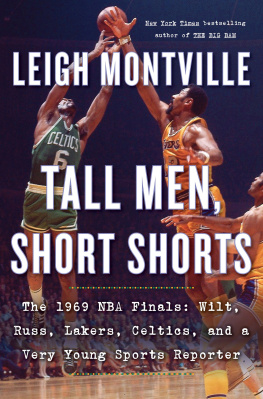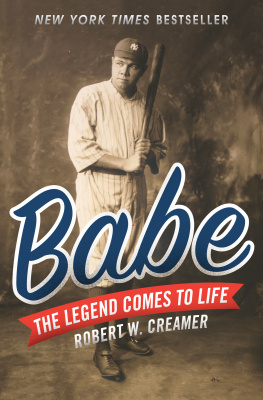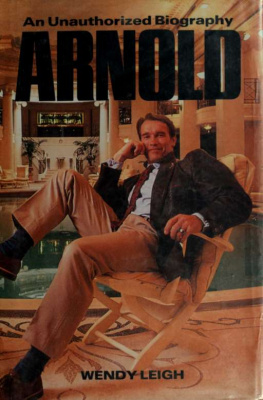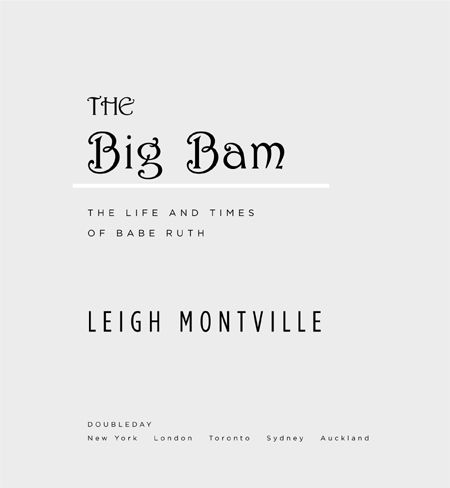Leigh Montville - The Big Bam: The Life and Times of Babe Ruth
Here you can read online Leigh Montville - The Big Bam: The Life and Times of Babe Ruth full text of the book (entire story) in english for free. Download pdf and epub, get meaning, cover and reviews about this ebook. year: 2006, publisher: Doubleday, genre: Detective and thriller. Description of the work, (preface) as well as reviews are available. Best literature library LitArk.com created for fans of good reading and offers a wide selection of genres:
Romance novel
Science fiction
Adventure
Detective
Science
History
Home and family
Prose
Art
Politics
Computer
Non-fiction
Religion
Business
Children
Humor
Choose a favorite category and find really read worthwhile books. Enjoy immersion in the world of imagination, feel the emotions of the characters or learn something new for yourself, make an fascinating discovery.

- Book:The Big Bam: The Life and Times of Babe Ruth
- Author:
- Publisher:Doubleday
- Genre:
- Year:2006
- Rating:3 / 5
- Favourites:Add to favourites
- Your mark:
The Big Bam: The Life and Times of Babe Ruth: summary, description and annotation
We offer to read an annotation, description, summary or preface (depends on what the author of the book "The Big Bam: The Life and Times of Babe Ruth" wrote himself). If you haven't found the necessary information about the book — write in the comments, we will try to find it.
He was the Sultan of Swat. The Caliph of Clout. The Wizard of Whack. The Bambino. And simply, to his teammates, the Big Bam. From the award-winning author of the New York Times bestseller Ted Williams comes the thoroughly original, definitively ambitious, and exhilaratingly colorful biography of the largest legend ever to loom in baseballand in the history of organized sports.
[Montville is] one of Americas best sportswriters. Chicago Tribune
Babe Ruth was more than baseballs original superstar. For eighty-five years, he has remained the sports reigning titan. He has been named Athlete of the Century . . . more than once. But who was this large, loud, enigmatic man? Why is so little known about his childhood, his private life, and his inner thoughts? In The Big Bam, Leigh Montville, whose recent New York Times bestselling biography of Ted Williams garnered glowing reviews and offered an exceptionally intimate look at Williamss life, brings his trademark touch to this groundbreaking, revelatory portrait of the Babe.
Based on newly discovered documents and interviewsincluding pages from Ruths personal scrapbooks The Big Bam traces Ruths life from his bleak childhood in Baltimore to his brash entrance into professional baseball, from Boston to New York and into the record books as the worlds most explosive slugger and cultural luminary. Montville explores every aspect of the man, paying particular attention to the myths that have always surrounded him. Did he really hit the called shot homer in the 1932 World Series? Were his home runs really the farthest balls ever hit in countless ballparks around the country? Was he really part blackmaking him the first African American professional baseball superstar? And was Ruth the high-octane, womanizing, heavy-drinking fatso of legend . . . or just a boyish, rudderless quasi-orphan who did, in fact, take his training and personal conditioning quite seriously?
At a time when modern baseball is grappling with hyper-inflated salaries, free agency, and assorted controversies, The Big Bam brings back the pure glory days of the game. Leigh Montville operates at the peak of his abilities, exploring Babe Ruth in a way that intimately, and poignantly, illuminates a most remarkable figure.
Leigh Montville: author's other books
Who wrote The Big Bam: The Life and Times of Babe Ruth? Find out the surname, the name of the author of the book and a list of all author's works by series.







